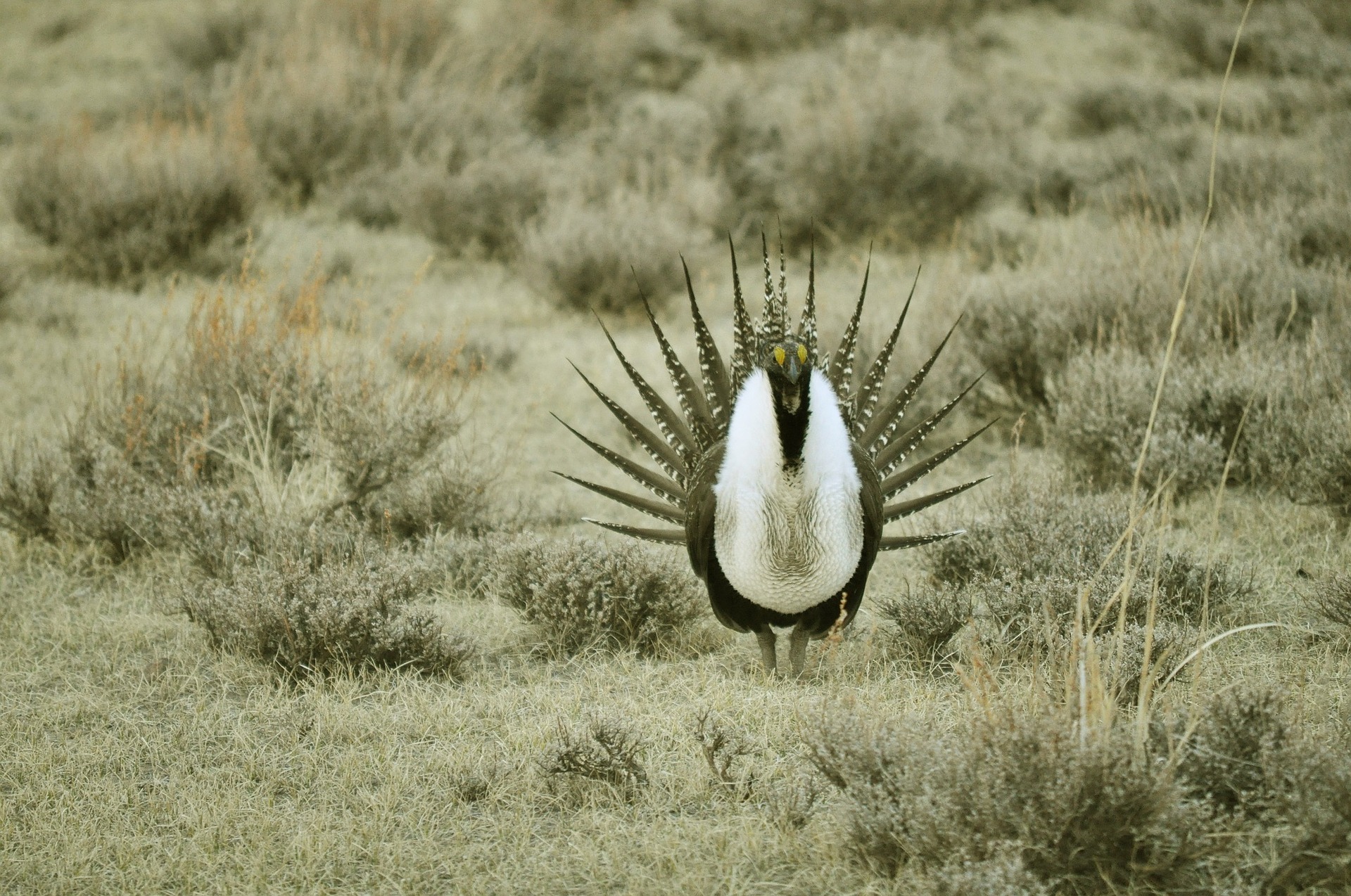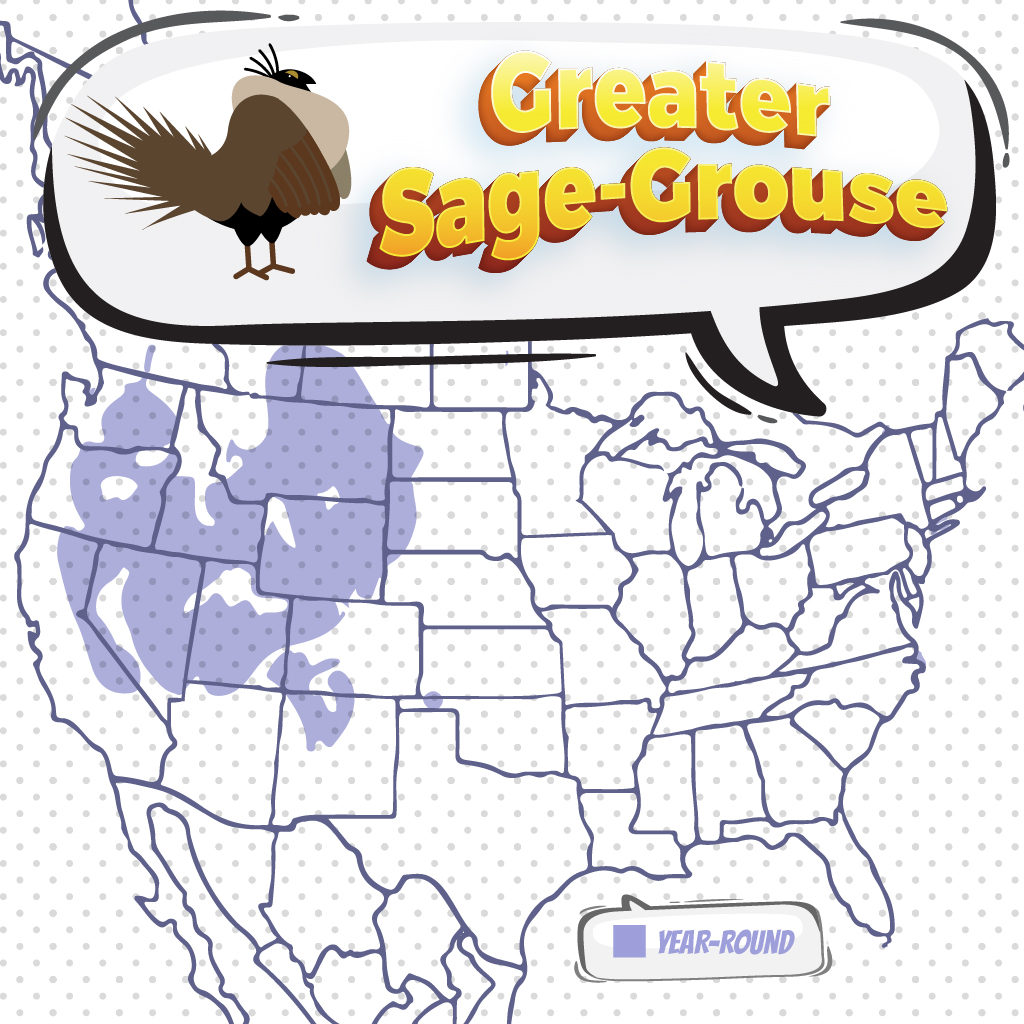
The Greater Sage Grouse
A Greater Sage Grouse is a fun bird to see while bird watching. Below are some tips to help you identify Greater Sage Grouses. We have also put together a list of fun Greater Sage Grouse t-shirts, Greater Sage Grouse bird patches, birdhouses, bird feeders, binoculars, stickers, and other fun bird-watching items.
About Greater Sage Grouses
They are the largest North American grouse, found in sagebrush country of the west. They are an attraction to birders due to their stellar displays during courtship. The males gather in spring and perform traditional dances hoping to attract females. Over the winter, these grouse build on their weight and strength as they prepare for their breeding season. Some of their distinctive features include:
Description and Identification
Greater Sage Grouses are large, chubby birds about 22 – 30 inches long. They have small
heads, round bodies, and long tails. The males are known to be able to change shape when
they display during courtship, becoming almost spherical when they puff up their chests,
droop their wings, and fan their tails into a starburst. Both sexes have grayish-brown
plumages with black bellies and white breasts. Males have blackheads, black throats, and a
pair of inflatable yellow air sacs that are surrounded by fluffy white ruffs on the breast during
courtship. The females are speckled with brown and gray above with more brown speckling
on their throats and bellies. They are characterized by white eye markings behind the eye
and dusky cheek patches.
Greater Sage Grouse Color Pattern
They are primarily mottled gray-brown with a black underpart. The males have blackheads and throat. Their breast is fluffy white which surrounds a pair of yellow air sacks that are visible during their display. The female sage-grouse has white markings behind their eyes.

Greater Sage Grouse Size
These large grouse have long tails, rounded bodies, and small heads. During display, the males significantly change shape, assuming an almost spherical shape. Although larger than a ring-necked pheasant, they are dwarfed by a wild turkey.
The relative size of both sexes
- Length range: 22.1-29.5 in (56-75 cm)
- Weight: 49.4-102.3 oz (1400-2900 g)
- Wingspan range: 28-38 in (71-97 cm)
Greater Sage Grouse Behavior
They predominantly browse on sagebrush and other plants. They can also forage by picking items on the ground. In March and May, males perform strutting displays on leks in a bid to attract females for courtship.
Greater Sage Grouse Food
Greater Sage Grouses mainly eat leaves, buds, flowers, forbs, and insects. The leaves of
sagebrush dominate their diet throughout the year, along with other herbaceous leaves.
Perennial bunchgrasses are also regularly consumed. Since these birds lack muscular
gizzards, they cannot grind and digest seeds – making them entirely dependent on soft-
tissue foods. These specific requirements make them highly selective. Other plants that they
consume include dandelions, legumes, yarrow, and wild lettuce. These forbs are especially important for females when they prepare to lay eggs. Juveniles cannot digest sagebrush in
the first three weeks after hatching and thus consume various insects like beetles,
grasshoppers, and ants.
They mostly feed on sage leaves and buds. They also devour insects when available. In fall and winter, their diet comprises leaves and shoots of sagebrush. During other seasons, they feed on leaves, flowers, and buds of numerous plants. In summer, they can supplement their diet with insects.
Greater Sage Grouse Habitat
These birds are primarily found on sagebrush plains and sagebrush steppe of western North
America but can also inhabit foothills and mountain slopes where sagebrush grows. While
they are dependent on sagebrush for survival, they can use several different types of
sagebrush habitats throughout the year. They tend to gravitate towards areas with dense
covers from big sagebrush, but can also be found in areas with rabbitbrush, greasewood,
and other grassy areas. Leks – areas where males gather to perform elaborate courtship
rituals and compete for mates – are chosen in clear areas like dry lakebeds, grassy swales,
broad ridgetops, and recently burned areas. Areas with good forage are sometimes chosen
for growing chicks by the females, with the regions including irrigated pastures, wet
meadows, and alfalfa fields.
They predominantly thrive in the sagebrush of western North America. They usually nest in areas with dense covers such as sagebrush, greasewood, and rabbitbrush. Leks can be found in recently burned areas or dry lake beds.
Range and Migration

Greater Sage Grouses – also known as Sagehens – is the largest grouse found in North
America. They are permanent residents of their breeding grounds in southern Canada and
the western United States. Found throughout the sagebrush country of western North
America, these birds are a sight during their mating seasons. Their natural range is limited to
the sagebrush country, making them especially susceptible and vulnerable to climate
change influencing their habitats. These birds are nonmigratory but may travel short
distances around 20 miles in search of food during seasonal changes.
Greater Sage Grouse Lifecycle
The females lay 7-9 eggs and incubate them for 25-27 days. The young ones can leave the nest shortly after hatching. They feed themselves but are taken care of by the female. They fledge after 1-2 weeks. They can live up to 9 years in the wild.
Greater Sage Grouse Nesting
All the nest-building is done by the females without any help from the males. The nests are
placed on the ground under sagebrush shrubs and sometimes be under tufts of grass within
dense patches of shrubs as well. At least two directions of the nests are not covered by
heavy vegetation, presumably to provide escape routes for incubating females in the event
of a predator attack. The nests are bowl-shaped depressions that are scraped into soft soil.
These depressions are then lined with leaves, grasses, forbs, small twigs, and the female’s
breast feathers. The clutch size generally ranges between 4 – 11 eggs.
Ornithology
Bird Watching Academy & Camp Subscription Boxes
At Bird Watching Academy & Camp we help kids, youth, and adults get excited and involved in bird watching. We have several monthly subscription boxes that you can subscribe to. Our monthly subscription boxes help kids, youth, and adults learn about birds, bird watching, and bird conservation.
- Kids Bird Watching Monthly Subscription$10.00 / month
- Kid & Adult Bird Watching Starter Pack Subscription$10.00 / month and a $72.00 sign-up fee
- Kids Bird Watching Starter Pack Subscription$10.00 / month and a $19.00 sign-up fee
Bird Watching Binoculars for Identifying Greater Sage Grouses
The most common types of bird watching binoculars for viewing Greater Sage Grouses are 8×21 binoculars and 10×42 binoculars. Bird Watching Academy & Camp sells really nice 8×21 binoculars and 10×42 binoculars. You can view and purchase them here.
- Birding Binoculars$49.99
- Kids Binoculars$13.99
Greater Sage Grouse T-shirts
If you love the Greater Sage Grouse you should purchase a Bird Watching Academy & Camp T-shirt. To help support bird conservation we donate 10 percent to bird conservation activities.
Greater Sage Grouse Iron On Patches
Kids, Youth, and Adults love to collect our Bird Watching Academy & Camp iron-on patches. Our bird-watching patches help you keep track of the birds you have seen and identified. You can also display the patches on our Bird Watching Academy & Camp banners.
The Greater Sage Grouse is a great iron-on patch to start your collection with. The patches are durable and can be sewn on or ironed on to just about anything.
Greater Sage Grouse Stickers
Stickers are a great way for you to display your love for bird watching and the Greater Sage Grouse. We sell a monthly subscription sticker pack. The sticker packs have 12 bird stickers. These sticker packs will help your kids learn new birds every month.
Bird Feeders for Greater Sage Grouse
There are many types of bird feeders. Here are our favorite bird feeders for your backyard. We use all of these bird feeders currently. Kids will have a great time watching birds eat at these bird feeders. Using this collection of bird feeders will provide a wide variety and many types of birds.
Best Bird Houses for Greater Sage Grouse
There are many types of birdhouses. Building a birdhouse is always fun but can be frustrating. These 4 birdhouses have become our favorites. Getting a birdhouse for kids to watch birds grow is always fun. We spent a little extra money on these birdhouses but they have been worth the higher price and look great.









